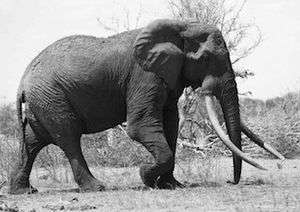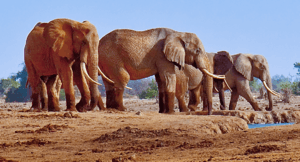Satao (elephant)
Satao (c. 1968 – 30 May 2014) was one of Kenya's largest African elephants. He was known as a tusker because his tusks were so long that they almost touched the ground. The Tsavo Trust announced that Satao was killed by poachers using a poisoned arrow on 30 May 2014.
 Satao, one of Kenya's tuskers | |
| Species | African bush elephant (Loxodonta africana) |
|---|---|
| Sex | Male |
| Born | c. 1968 |
| Died | 30 May 2014 (aged 45-46) |
| Known for | Being Kenya's iconic elephant |
Background
Satao was an African elephant that lived in Tsavo East National Park, one of the largest wildlife parks in the world with a large population of elephants. He was thought to have been born during the late 1960s and to have been at least 45 years old when he was killed. He was estimated to be one of the largest elephants in the world at the time of his death and has been described as one of Kenya's most iconic and well-known tuskers (i.e., male elephants with tusks that almost reach the ground). Satao's tusks were over 6.5 feet (2.0 m) long[1] and he was estimated to be the largest of the few remaining tuskers living in Kenya.[2][3][4][5][6] It is believed that all of the remaining tuskers are in Kenya.[1]

Elephant ivory poaching is a huge problem in Africa. In 2013, over 20,000 African elephants were slaughtered for their ivory. The slaughter of African elephants is driven by the black market value of elephant ivory. The illicit trade in ivory is primarily in Asia where ivory sells for several thousands of dollars per kilo.[7] Satao's tusks were estimated to weigh more than 100 pounds (45 kg) each.[2][3][4][5][6]
Since 2007, the illegal trade in ivory had doubled. While China is the largest market, the United States, Thailand, Vietnam, and the Philippines are also top markets for illegal ivory.[8] The increase in poaching is driven in large part by organised crime and rebel groups seeking ways to fund insurgencies in Africa.[9]
Due to the great value of his tusks on the black market, Satao had been under nearly constant surveillance by the Kenya Wildlife Service (KWS) and the Tsavo trust for the 18 months prior to June 2014. He typically remained in a small area of the park, but had started roaming into areas of the park where poaching was high.[8] Because he roamed into a large 390-square-mile area (1,000 km2),[1] a dangerous area for poaching with thick vegetation, and because of the constant poaching attempts driven by organised crime and rebel militias, the KWS and the Tsavo Trust could not prevent poachers from reaching Satao.[2][3][4][10][5][6][9]
Also, Satao was featured in the Apple TV+ original the Elephant Queen however during their filming for the documentary, Satao was killed by the poachers.
Death
In March 2014, Satao was found with two seeping wounds in his flank from poisoned arrows shot into him, which were confirmed by veterinarians who rushed to the scene to treat him. After a number of days, Satao recovered from his festering wounds.[3] Satao was last spotted alive on 19 May 2014.[11]
On 2 June 2014, Richard Moller of the Tsavo Trust found a huge elephant carcass lying in a swamp near the boundary of Tsavo East National Park. The tusks had been cut off and the face was badly mutilated, so the carcass could not be identified with certainty at that time. For about 10 days, Moller and Kenya Wildlife Service searched for Satao before concluding that he was dead. He was killed by a poisoned arrow shot deep into his left flank on 30 May 2014.[2][3][4][5][6][11]
Satao was officially declared dead on 13 June 2014 and the Tsavo Trust released the following statement announcing his death:[1]
It is with enormous regret that we confirm there is no doubt that Satao is dead, killed by an ivory poacher's poisoned arrow to feed the seemingly insatiable demand for ivory in far off countries. A great life lost so that someone far away can have a trinket on their mantlepiece. Rest in peace, Old Friend, you will be missed.[1][9]
Satao was a victim of the illegal ivory trade where ivory is commonly poached and sold by terrorist organizations to China, which has the largest market for ivory in the world.[12][13][14]
Arrests
On 20 June 2014, Kenya Wildlife Services reported that service rangers arrested three suspects for killing Satao. Paul Muya, a spokesperson for the Kenya Wildlife Services said that they were tracked down based on intelligence the Service had acquired.[15]
See also
References
- Dell'Amore, Christine (16 June 2014). "One of Kenya's most adored elephants, who had giant tusks and was known as Satao, has been killed for his ivory—a "monumental" loss, experts say". National Geographic. Archived from the original on 18 June 2014. Retrieved 18 June 2014.
- Peralta, Eyder (14 June 2014). "One of Kenya's Legendary 'Tuskers' Is Killed By Poachers". NPR. Archived from the original on 15 June 2014. Retrieved 15 June 2014.
- Kahumbu, Paula (2014). "Kenya's biggest elephant killed by poachers". The Guardian. Archived from the original on 15 June 2014. Retrieved 15 June 2014.
- Flood, Zoe (14 June 2014). "Poachers kill one of the world's largest elephants in Kenya". The Daily Telegraph. Archived from the original on 15 June 2014. Retrieved 15 June 2014.
- Bryant, Christian (14 June 2014). "Popular elephant named Satao killed in Kenyan park". The Atlanta Journal-Constitution. Archived from the original on 15 June 2014. Retrieved 15 June 2014.
- Staff (15 June 2014). "Kenya's iconic elephant Satao is dead in Tsavo". Kenya Television Network. Archived from the original on 15 June 2014. Retrieved 15 June 2014.
- Nsehe, Mfonobong (15 June 2014). "World Famous Elephant 'Satao' Killed By Poachers in Kenya". Forbes. Archived from the original on 17 June 2014. Retrieved 17 June 2014.
- Karimi, Faith (15 June 2014). "Poachers kill beloved Kenyan elephant known for giant tusks". CNN. Archived from the original on 17 June 2014. Retrieved 17 June 2014.
- AFP and Network Writers (16 June 2013). "Kenya's famous bull elephant Satao slain in Tsavo by poachers with poison arrows". The Australian. Archived from the original on 17 June 2014. Retrieved 17 June 2014.
- Saul, Heather (14 June 2014). "Satao, Kenya's 'iconic' elephant, is killed by poachers". Times of India. Archived from the original on 15 June 2014. Retrieved 15 June 2014.
- Zerkel, Eric (16 June 2014). "Satao, One of the World's Largest African Elephants, Poisoned to Death, Mutilated in Tsavo, Kenya". The Weather Channel. Archived from the original on 17 June 2014. Retrieved 17 June 2014.
- "Africa: Biggest Elephant Satao Killed with Poisoned Arrows in Ivory Poaching Attack". IBT/Yahoo News network. 16 June 2014. Retrieved 25 June 2014.
- "Elephants slaughtered for trinkets and terrorism". CNN. 8 February 2014. Retrieved 25 June 2014.
- "Poachers kill beloved Kenyan elephant known for giant tusks". CNN. 15 June 2014. Retrieved 25 June 2014.
- MWadime, Ralpael (21 June 2014). "Satao suspected killers arrested". The Star. Archived from the original on 25 June 2014. Retrieved 25 June 2014.